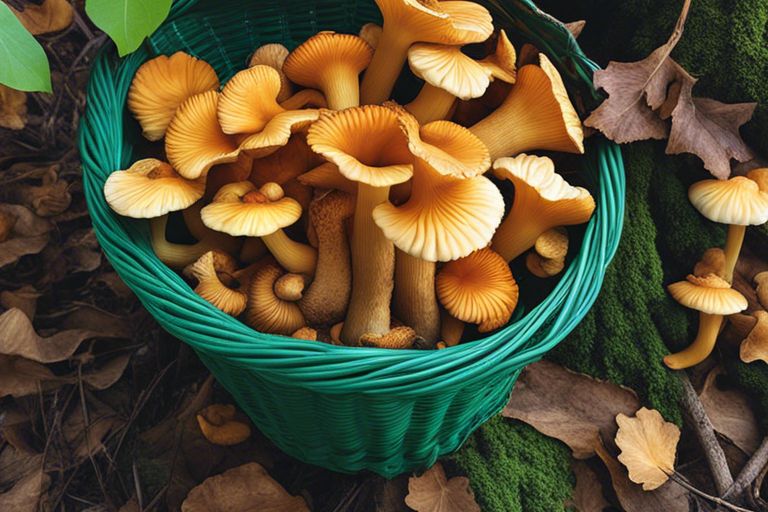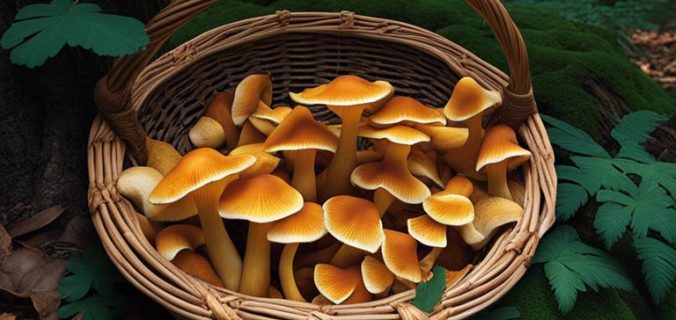It’s in the quiet depths of the forest where you can uncover the hidden treasure of chanterelle mushrooms. With their golden hue and delicate aroma, these wild fungi are not just a culinary delight but your gateway to the wonders of the woods. In this informative guide, you will learn how to identify, harvest, and savor these prized mushrooms while treading lightly in nature’s embrace.
Key Takeaways:
- Distinct Flavor: Chanterelle mushrooms have a unique and delicious flavor profile, described as fruity, peppery, and earthy.
- Nutritional Benefits: They are a good source of vitamins, minerals, and antioxidants, offering health benefits such as boosting the immune system and supporting heart health.
- Foraging Adventures: Chanterelles are prized by chefs and food enthusiasts and are often foraged in forests, adding an element of adventure to the culinary experience.
Habitat and Distribution
Native Regions
To truly appreciate the beauty of chanterelle mushrooms, you must first understand where they come from. Chanterelles are commonly found in the Northern Hemisphere, particularly in temperate forests of Europe, Asia, and North America. You can spot them in coniferous and hardwood forests alike, thriving in moist environments where they can establish a symbiotic relationship with tree roots.
These prized mushrooms often hide beneath the leaf litter, peeking out during the warm, wet months of late summer and fall. Foraging for chanterelles in their native regions can be a delightful adventure, as you wander through the tranquil woods in search of these golden treasures.
Forest Types
An important aspect to note when seeking out chanterelle mushrooms is the specific types of forests where they grow. Chanterelles prefer temperate forests over boreal or tropical environments. They are commonly found in mixed forests that have a combination of coniferous and deciduous trees.
| Coniferous Forests | Deciduous Forests |
| Spruce, pine, and fir trees | Oak, beech, and birch trees |
| Cool and moist climate | Varied climate conditions |
| Shady and acidic soil | Rich and well-drained soil |
| Typically found in northern regions | Common in temperate zones |
Knowing the preferred habitats of chanterelles can significantly improve your chances of a successful foraging expedition.
Identification and Characteristics
Any Guide to Golden Chanterelle Mushrooms will tell you that these prized fungi have distinctive characteristics that set them apart from other mushrooms. Let’s explore how to identify them in the wild.
Cap Shape and Color
On your foraging adventures, you’ll notice that Chanterelle mushrooms have a vase-shaped cap with wavy, rounded edges. The color of their caps can range from pale yellow to a deep golden hue, giving them their signature nickname of “golden chanterelles.”
Stem and Gills
For identification purposes, pay attention to the stems of Chanterelles, which are often tough and sturdy. Unlike gilled mushrooms, Chanterelles have blunt, shallow ridges on the underside of the cap instead of true gills. This feature, along with their lack of a ring or veil on the stem, helps distinguish them from look-alike species.
When identifying Chanterelle mushrooms, remember that their stems are usually the same color as the cap and can appear almost fused to the underside of the mushroom. This unique characteristic is key in differentiating them from potentially harmful species, so be sure to observe it closely.
Size and Weight
Identification of Chanterelle mushrooms also involves considering their size and weight. Typically, these mushrooms range from two to four inches in diameter, with the larger ones weighing up to a few ounces. Their relatively light weight compared to their size is another clue that you’ve stumbled upon these forest treasures.
Gills
When foraging for Chanterelles, remember that their lack of true gills distinguishes them from poisonous look-alike species, making them a safer choice for consumption.
Color
The vibrant golden color of Chanterelle mushrooms is not only visually appealing but also a key characteristic that sets them apart from other fungi. This distinctive hue can guide you in confidently identifying these delectable treasures in their natural habitat.
Culinary Delights
Flavor Profile
All that glitters is not gold, but in the case of chanterelle mushrooms, their golden hue is matched by their rich and earthy flavor. These mushrooms have a distinct taste that is described as fruity, nutty, and slightly peppery, making them an excellent addition to various dishes.
Cooking Methods
To make the most of chanterelle mushrooms’ unique flavor, it’s best to cook them simply. Sautéing them in butter or olive oil with garlic and fresh herbs allows their flavor to shine, while adding them to soups, pastas, and risottos brings a depth of flavor to the dish.
Pairing Suggestions
A classic way to enjoy chanterelle mushrooms is to pair them with other ingredients that complement their earthy flavor. Try serving them with grilled meats, poultry, or seafood for a delicious and nutritious meal.
Nutritional Value
Unlike many other mushrooms, Chanterelles are not only prized for their exquisite taste but also for their impressive nutritional value. These golden delicacies are not only delicious but also packed with necessary vitamins, minerals, and antioxidant properties that offer a myriad of health benefits.
Vitamins and Minerals
To start, Chanterelle mushrooms are an excellent source of vitamin C, vitamin D, potassium, and iron. These vitamins and minerals play a crucial role in supporting your immune system, promoting bone health, and boosting your overall well-being.
Antioxidant Properties
Antioxidants are compounds that help protect your cells from damage caused by free radicals. Chanterelle mushrooms contain high levels of antioxidants, such as ergothioneine and carotenoids, which help reduce inflammation, promote healthy aging, and may even lower the risk of chronic diseases.
The antioxidant properties of Chanterelle mushrooms make them an excellent addition to your diet, helping you combat oxidative stress and maintain optimal health.
Health Benefits
The consumption of Chanterelle mushrooms has been linked to a range of health benefits. These golden delights may help reduce inflammation, support heart health, and boost your immune system. Additionally, their high fiber content can aid in digestion and weight management.
To reap the full health benefits of Chanterelle mushrooms, consider incorporating them into your meals regularly. Whether sautéed, roasted, or added to soups and stews, these mushrooms can elevate both the flavor and nutritional profile of your dishes.
Nutritional powerhouse Chanterelle mushrooms are not only a culinary delight but also a treasure trove of necessary nutrients and health-promoting properties. Including these golden delicacies in your diet can not only tantalize your taste buds but also nourish your body from the inside out.

Harvesting and Sustainability
Not only are chanterelle mushrooms a prized culinary delicacy, but they also play a crucial role in the ecosystem. Responsible foraging is important to ensure the sustainability of these golden treasures. When harvesting chanterelles, it’s important to only pick the mushrooms that are fully mature and leave the smaller ones to allow for continued growth and reproduction.
Sustainability: Responsible Foraging
Sustainability should always be at the forefront of your mind when foraging for chanterelle mushrooms. Make sure to only pick what you can use and avoid over-harvesting. By following sustainable foraging practices, you can enjoy these delectable mushrooms for years to come.
Seasonal Availability
When considering chanterelle mushrooms, their seasonal availability is a key factor to consider. These mushrooms flourish in the late summer and fall months, typically appearing after a period of rain. Their seasonality adds to the allure of hunting for them in the forest.
Seasonal changes can greatly affect the abundance and quality of chanterelle mushrooms. Be sure to familiarize yourself with the ideal conditions for their growth to optimize your harvesting efforts.
Conservation Efforts
Harvesting chanterelle mushrooms should always be accompanied by efforts to preserve and protect their natural habitats. Conservation efforts such as advocating for sustainable foraging practices, supporting protected areas, and educating others about the importance of preserving these fungi are crucial to maintaining their existence in the wild.
With your understanding and commitment to responsible foraging practices and conservation efforts, you can help ensure that chanterelle mushrooms continue to thrive in the forest for future generations to enjoy.
Cultural Significance
Historical Use
Keep in mind that chanterelle mushrooms have been treasured for centuries for their unique flavor and nutritional benefits. Historically, these mushrooms were highly regarded in European cuisine and were even served to royalty. They were believed to have medicinal properties and were used in traditional medicine to treat various ailments.
Folklore and Mythology
With a rich history steeped in folklore and mythology, chanterelle mushrooms have captured the imagination of people around the world. In Scandinavian folklore, it was believed that chanterelles were associated with the mythical “Hidden Folk” and were considered a symbol of good luck. In some cultures, it was thought that chanterelles marked the location of hidden treasure, adding to their mystique and allure.
This connection to folklore and mythology has given chanterelle mushrooms a magical and mystical aura, adding to their appeal and desirability among foragers and chefs alike.
Modern Appreciation
Mythology has evolved with time, and chanterelle mushrooms continue to hold a special place in modern culinary culture. Chefs and food enthusiasts worldwide cherish chanterelles for their delicate flavor and golden hue. They are often featured in gourmet dishes and are a coveted ingredient in high-end restaurants. Their popularity has only grown over the years, solidifying their status as a culinary delicacy.
Understanding the cultural significance of chanterelle mushrooms allows you to appreciate not only their culinary value but also the deep-rooted connections they hold to history, folklore, and modern gastronomy. Whether you enjoy them sautéed in butter, added to a creamy risotto, or simply grilled with olive oil and herbs, chanterelles offer a taste of the forest’s golden treasure that has enchanted people for centuries.
Final Words
Upon reflecting on the enchanting world of chanterelle mushrooms, you cannot help but marvel at nature’s intricate beauty and the delicate balance that exists within the forest. The golden hue of these mushrooms symbolizes not just their exquisite taste but also the treasure trove of natural wonders that our planet holds. So next time you find yourself wandering through the woods, keep an eye out for these golden delicacies and remember to treat them with the reverence they deserve.
Chanterelle mushrooms are indeed a rare and precious gift from the forest, a reminder of the magic and mystery that surround us in the natural world. The next time you savor their rich flavor and delicate texture, take a moment to appreciate the intricate web of life that has brought these golden treasures into your hands. Cherish each bite, for in doing so, you honor not just the chanterelles themselves, but the entire ecosystem that supports their growth and nourishment.
FAQ
Q: What do chanterelle mushrooms look like?
A: Chanterelle mushrooms are known for their vibrant golden-yellow color and their funnel-shaped caps. They have a meaty texture with a delicate, slightly fruity flavor.
Q: Where can I find chanterelle mushrooms?
A: Chanterelle mushrooms can be found in wooded areas, particularly in coniferous and mixed forests. They grow on the ground near trees, often hidden beneath leaf litter or moss.
Q: How do I cook chanterelle mushrooms?
A: Chanterelle mushrooms are versatile and can be sautéed, roasted, or even pickled. To cook them, simply clean them gently with a brush or damp cloth, and then slice or chop them as desired before adding them to your favorite recipes.

